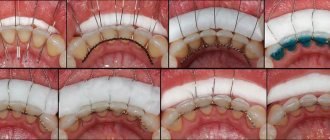Many people believe that braces destroy enamel, promote tooth decay, and cause other dental diseases. Is this really true? Should a person refuse orthodontic treatment if there is a risk of damage to teeth or gums? In this article we will answer these questions.
In this article
- Do braces damage teeth?
- Why do teeth get damaged from braces?
- How to prevent enamel damage when wearing braces
- Hygiene with braces
Braces are complex structures consisting of several parts: screws, locks, arches, etc. As a rule, they are made of metal. If the system is made of another material, such as plastic, ceramic or sapphire, the arc will still be metal. The braces are fixed directly to the tooth enamel using special dental glue and cement. They cannot be removed. A person has to wear the appliance for several months or years, it all depends on the pathology of the bite.
Many patients who have undergone orthodontic treatment report that their teeth deteriorate due to braces. In their opinion, while wearing a dental structure, the enamel becomes thinner, caries often develops, gums become inflamed, etc. According to doctors, such complications occur in medical practice, but braces are not to blame. Let's find out what exactly causes these complications.
Myth 1. Braces damage tooth enamel.
The enamel does not deteriorate directly due to the fixation of braces. Firstly, according to the system installation protocol, a complex of professional hygiene with the removal of dental plaque is first performed. In addition, the place where the bracket is fixed to the tooth is treated with a special disinfecting gel, then the bracket is tightly glued to the tooth. Therefore, bacterial plaque cannot get under it. The enamel around the bracket is the place that is more difficult to clean due to difficult access. If the patient has been selected with the necessary brushes and brushes, taught the correct cleaning technique, and he conscientiously follows the recommendations, and at the same time goes for professional hygiene at least once every 4 months, then there will be no problems with the enamel. We remove the braces and your teeth look exactly the same as they did before treatment. If you take hygiene with braces lightly, then chalky or brown spots of demineralization may appear on the enamel around the structures - areas devoid of minerals, dangerous in terms of the development of caries. We see this quite often in teenagers with poor oral hygiene.
How to prevent enamel damage when wearing braces
To maintain dental health while wearing orthodontic braces, the patient must adhere to a diet and carefully practice good hygiene. First, we’ll tell you how a person with braces should eat.
Immediately after their installation, you can only eat soft or liquid food in order to quickly get used to the design. Subsequently, you should refuse:
- Hard products: nuts, a number of fruits and vegetables, dried fruits, crackers, hard meat, etc. They can damage the arch structure, gums or enamel. Damage to braces will require additional costs. However, this does not mean that you will have to completely exclude carrots, nuts and other foods from your diet - they can be eaten pureed.
- Sticky food: candies and chocolate with nougat, corn flakes, chewing gum, cheeses, etc. The remains of such products stick to the braces and become a source for the spread of bacteria. In addition, most of these foods contain a lot of fast carbohydrates, which feed cariogenic bacteria. Because of this, caries can develop.
- Products with small grains: raspberries, chia, sesame, strawberries, kiwi, etc. The seeds from these products end up in locks, and it is quite difficult to clean them out. The functionality of the braces may be impaired. In addition, microbes will begin to actively multiply in the parts of the staples, which contribute to the occurrence of various diseases.
- Foods and drinks with dyes: coffee, tea, soda, etc. You don’t need to give them up completely, but you will still have to limit their consumption, otherwise the braces will darken first, and then the enamel. In addition, dyes cause plaque and tartar to form faster, which is a favorable environment for the spread of bacteria.
Also, a patient with braces needs to observe the temperature regime while eating. It is not recommended to eat food that is too hot or cold, which can affect the braces and enamel. While wearing braces, it is advisable to eat healthy foods containing vitamins and minerals. They speed up the process of restoring the structure of the tooth surface.
Myth 2. Age affects the ability to be treated with braces.
Many patients are surprised that they can be treated with braces at 30, 40, 50, 60 and 70 years old! And in general at any age.
There are two categories of orthodontic patients:
- The patient is at the stage of jaw growth, peak growth usually occurs at 11-12 years of age.
- The patient is no longer growing - he has a full set of teeth and jaw growth has stopped, most often he is 15-16 years old and older.
In the first case, the orthodontist works with the teeth and jaw, in the other - only with the teeth. At the stage of stopped growth, jaw correction can only be performed by an orthognathic surgeon. But there are no age restrictions for aligning the dentition and correcting the bite.
The effect of locking joints on teeth
The erroneous opinion that the locking connections of braces cause damage to the enamel surface causes a lot of prejudices, which are cited as arguments for reluctance to use orthodontic structures.
The clasps are attached to the teeth using a special adhesive. It eliminates contact with the enamel, since the existing gap is completely sealed. In addition, fluorine and other useful microelements are used in the glue, which creates an obstacle to the development of carious cavities.
Therefore, orthopedic structures to correct malocclusion do not cause damage to the color and integrity of the surface enamel. This is facilitated by the lack of proper hygienic care and the consumption of rough food during the period of use of the braces system.
Sometimes a violation of the integrity of tooth enamel becomes a consequence of poor-quality work by an orthodontist. In this case, food particles penetrate under the locks, which causes the growth of pathogenic microflora.
Important! To prevent mistakes when fixing a brace system, you need to take the right approach to choosing a dental clinic, inquire about its reputation and the qualifications of the specialists who practice there.
Excellent motivation for installing braces and ways to solve possible problems.
Come here if you are interested in the pros and cons of composite braces.
At this address https://orto-info.ru/sistemyi-vyiravnivaniya-zubov/breketyi/luchshe-postavit-posle-30-let.html we will discuss whether it is worth installing braces at 30 years old.
Myth 3. You need to come to the orthodontist when all your permanent teeth have erupted.
This myth is often spread by dentists. They say that, despite the problems, there is no need to show the child to the orthodontist now, let all the teeth erupt.
This is an outdated approach. Indeed, there are situations in which it is worth waiting for a complete change in the bite. But there are problems that require urgent treatment, sometimes even at 5-6 years old. These are mainly pronounced bite pathologies - an overdeveloped upper or lower jaw, which is caused by bad habits, and if we wait until all the teeth erupt and jaw growth stops, then surgery will be the only option to solve the problem. There is no need to condemn your child to this from the very beginning.
Sometimes, even in early childhood, the doctor and parents notice that the child swallows incorrectly or has a bad habit of sucking his tongue, finger, or some other object. In this case, it is enough to pay attention to this habit and start fighting it early - either on your own or with the help of a speech therapist with special exercises. There are also orthodontic devices for correcting such habits - for example, a plate with a tongue barrier.
While the child is small, has baby teeth and jaws are still growing, it is often enough to remove the cause of the developing bite pathology. If this is not done in time, this can lead to significant deformities that will be very difficult or impossible to treat without surgery.
There are two stages of jaw growth spurts - at 1.5 years and at 6-7 years. This moment can be used to stimulate jaw growth using devices. If the child wears the removable device well, the treatment will work. But parents’ efforts are also needed, because the child’s compliance with the recommendations must be monitored.
Therefore, it is obvious that it makes sense to visit an orthodontist and, if there are problems, start working on them as early as possible, so as not to miss the moment to give your child a beautiful smile and harmonious facial features.
What after braces?
After achieving the desired result, the braces are removed. But the work on a beautiful smile does not end there. Now you need to “force” the teeth to remain in the same position. This is the task of retainers and aligners. A retainer is a metal wire that is placed on the inside of the front central teeth. It is secured using a special filling material. Serves as a kind of stabilizer and prevents teeth from moving apart.
A mouthguard is a completely transparent lining that fits tightly to the tooth enamel. Made from biopolymer materials. This eliminates the risk of allergic reactions.
Mouth guards are comfortable to wear and invisible to others.
The teeth must get used to the new position, because the body constantly resists and demands that everything be returned to its place. If you neglect to install retainers or aligners, the results from wearing braces for many months can quickly disappear.
Myth 4. About eighth teeth
There is such a common opinion among orthodontists and dentists that when the eighth teeth, or so-called “wisdom teeth,” erupt, they do not have enough space in the dentition, and they allegedly begin to push the teeth in front, leading to curvature. Also, patients often complain of crowded teeth after the appearance of “eights”, and by the time of treatment these teeth may have already been removed. In fact, no one has scientifically proven the relationship between the eruption of wisdom teeth and the appearance of crowding. Even in people with the rudiments of the eighth teeth already removed in childhood, curvature in the anterior section may appear due to gradual abrasion and, as a result, narrowing of the dentition. In addition, with age, the periodontal ligaments that hold the teeth in the bone tissue weaken, which can also cause a change in their position.
Malocclusion - an aesthetic defect
For most people in adulthood, aesthetic defects become the motivator for installing braces. An incorrect bite spoils your smile and can cause facial asymmetry and the formation of early wrinkles, however, there are also more serious consequences.
Due to uneven dentition, the jaws do not close, resulting in uneven distribution of the load, the mandibular joint is affected, and inflammation of the periodontium and gums occurs. Also, bite pathology provokes premature wear of tooth enamel, frequent caries and its complications.
Bite correction with braces helps not only eliminate aesthetic defects, but also prevent dental diseases that can lead to premature tooth loss.
Myth 5. After the plate in childhood, braces are not needed
If a patient had treatment with a plate or partial braces in childhood, this does not always guarantee avoidance of orthodontic treatment in the future. Very often during consultations we hear from parents of teenagers that they previously had treatment with braces, in which case it is quite difficult to explain the need for repeated treatment. You need to understand that orthodontic treatment can be carried out in several stages. The first stage is in childhood with the help of a plate or partial braces, and the second stage is in adolescence, already at the stage of permanent dentition.
“Braces are ugly”
Today, braces are a fashion accessory. Many perceive them as an indicator of wealth and a sign that you care about your health. Currently, there is a large selection of brace systems: metal, sapphire, ceramic, etc. If you are not satisfied with the appearance of metal locks, you can choose crystal-transparent sapphire braces or tooth-colored ceramic braces, as well as combined options.
Beautiful braces are real.
And remember that correcting your bite with braces is possible not only in childhood. Adult patients also very often get braces, because it’s never too late to take care of the health and beauty of your smile!
How safe is treatment with braces?
There is an assumption that braces have a harmful effect on the enamel, causing caries, causing demineralization of the enamel. In fact, negative processes can occur due to insufficient hygiene due to the formation of dental plaque that provokes infections. With high-quality installation and proper care, no negative effects of braces on the enamel and dental health have been identified.
Many myths are associated with the disadvantages of orthodontic treatment with braces, which actually exist, as well as with the features and disadvantages of individual braces. If we leave aside the aesthetic side of the issue, the main disadvantage of wearing braces is some complication of hygienic requirements. In practice, this only requires a lot of effort for high-quality teeth cleaning and special devices that can be easily purchased at any pharmacy.
Types of braces and safety
All existing braces are divided into types depending on the material from which they are made, the design and method of installation or location of the systems. The choice of braces from a safety point of view is not critical; they all guarantee the absence of potential harm.
When selecting, it is worth taking into account the peculiarity of lingual (internal) braces, which are characterized by a shorter distance between individual braces inside a metal arch. When installing them, you should adhere to more careful hygiene, since a reduced view of the inner surface provokes the retention of food residues and complicates hygiene procedures.
Adaptation to lingual braces is more difficult, the correction period is longer, and installation requires the highest qualifications from the doctor. Patients may experience:
- increased salivation;
- temporary violation of diction;
- injury to the mucous membrane of the tongue.
Lack of proper care can trigger the development of caries and accelerate the processes of enamel demineralization.
Disadvantages of treatment with braces
To refute the most common myths and speculations about the dangers of braces, it is worth taking a closer look at the reasons for the appearance of some of them:
- Pain and discomfort. Braces cause some discomfort only in the first days after installation; as a result of pressure on the teeth, unusual sensations arise that soon pass. The gums may ache slightly, itch, different options are possible - the intensity and type of pain depends on the individual characteristics and complexity of each specific case, but most often the side effects are minimal and fleeting. Professional recommendations from your dentist will help you quickly eliminate any discomfort. The bite correction procedure itself is stressful for the body, so some symptoms are completely normal, adaptation to new conditions and sensations occurs quite quickly. After about a week, braces stop bothering you and simply become a normal part of your life.
- Braces are harmful to teeth. There is no direct evidence of this statement over the many years of existence of modern structures - braces themselves are absolutely safe, providing a gentle correction of the position of the teeth. Only the person himself during the treatment process can provoke dental problems if he is negligent in following the recommendations of the treating specialist. Insufficient quality hygiene can provoke the accumulation of plaque, which is the cause of stomatitis, caries, gingivitis and other unwanted diseases.
- Braces damage the enamel. If we are talking about the dangers of installing systems for enamel, it is necessary to identify all possible problems and eliminate them at the stage of examination and preparation. If the condition of the teeth initially indicates a lack of minerals, in order not to aggravate the problem, the doctor prescribes special procedures to prevent the threat of erosion. This must be done before installing an orthodontic appliance.
- Braces cause allergies. Contraindications of this kind occur; most often they are associated with the presence of gum disease or the body’s specific rejection of certain materials. To safely use orthodontic appliances, it is necessary to eliminate treatment-related problems in the mouth. There are special braces with a biologically neutral composition - gold, sapphire, which are an ideal material for all risk categories - allergy sufferers, people with gastrointestinal diseases and others.
Restorative techniques
Even if the patient correctly and regularly carries out hygienic care of the oral cavity after installing an orthopedic brace, after the treatment process, plaque and tartar remain on the enamel, and it loses its natural shade. Therefore, there are a number of dental procedures that will restore the original color.
Mechanical cleaning method
This technology is carried out using a special medical instrument (curette). The cleansing procedure is performed by a dentist, and only mineral deposits are removed.
Recently, the technique has lost its relevance due to the following reasons:
- during the procedure, there is a risk of damage to the surface coating of the tooth and gum tissue;
- takes a long period of time;
- accompanied by pain.
The method can be used if there are contraindications to other methods of cleansing. In some cases, manipulation is carried out using rotating brushes and special dental paste.
Laser whitening
The procedure is carried out using hydrogen peroxide. Activation of the therapeutic composition occurs under the influence of a laser emitter. By heating the plaque, moisture evaporates from it, which helps remove deposits from the enamel surface. The procedure has a number of advantages:
- takes no more than half an hour;
- high degree of quality of the final result;
- several sessions allow you to consolidate the whitening effect for several years;
- good prevention of caries;
- safety of the method.
A significant disadvantage of this technique is the presence of pain after the procedure, and an increased risk of disruption of metabolic processes in dentin.
Strengthening compounds
To strengthen tooth and gum tissue after wearing braces, it is allowed to use medications that contain vitamins and minerals.
In this case, the following drugs are prescribed:
- Asepta. The main ingredient is coral calcium. With systematic use over a period of one and a half months, dental tissue is restored.
- DentoVitus. It has a therapeutic effect due to the vitamin composition (C, A, E, B6) and such beneficial microelements as Copper, Fluorine, Calcium and Zinc, Silicon and Manganese.
- Rox. Plaque-preventing gel. Eliminates tooth sensitivity after removing braces.
- Kaltsinova. The optimized composition of minerals and vitamins increases the strength of dental tissue.
Application of special strips
This type of product whitens teeth due to its chemical composition. Each strip has three layers.
The surface and outer layers are made of thin plastic, the middle layer is impregnated with a special gel based on hydrogen peroxide. The oxidation process starts when the package is opened, and whitening occurs due to the deep penetration of the active substance into the dentin layer.
There are several types of whitening strips. For sensitive teeth, delicate strips are suitable. For normal ones, standard types of products are used. Strips with enhanced action allow you to restore the natural whiteness of teeth even in the case of a large accumulation of plaque.
It should be borne in mind that after removing braces, whitening strips can only be used after the remineralization procedure.
Composite restoration
If, after using corrective systems, procedures with a whitening effect do not produce positive results, then it is possible to use dental restoration using composite materials.
This technique has a number of the following advantages:
- speed of the procedure;
- achieving a high degree of aesthetic value;
- the procedure allows you to preserve healthy tissue;
- low cost.
A budget option for composite restoration are fillings made of acrylic, epoxies or photopolymers (the latter are considered universal and the most reliable).
Veneers
Stains after wearing braces can be hidden after installing veneers. They are thin plates that are fixed with adhesive to the front surface of the frontal incisors. This is a quick but expensive way to restore natural whiteness.
Microabrasion
This is a relatively new technique that allows you to get rid of white and age spots. For this purpose, a special abrasive mixture based on small particles of pumice and hydrochloric acid is used.
Using the grinding method, the dentist removes a thin layer of enamel (from 25 to 70 microns). This technique is effective if other treatment options do not lead to the desired effect. Also, its big advantage is the prevention of the development of caries at the initial stage.
In the video, the doctor will talk about how to strengthen and preserve enamel with braces.











